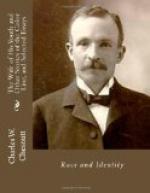“I don’t think it would be either right or kind to refuse them for any such reason, and I don’t believe I shall lose anything by it.”
She was somewhat surprised, and pleasantly so, when her class came together for their first lesson, at not finding them darker and more uncouth. Her pupils were mostly people whom she would have passed on the street without a second glance, and among them were several whom she had known by sight for years, but had never dreamed of as being colored people. Their manners were good, they dressed quietly and as a rule with good taste, avoiding rather than choosing bright colors and striking combinations—whether from natural preference, or because of a slightly morbid shrinking from criticism, of course she could not say. Among them, the dancing-mistress soon learned, there were lawyers and doctors, teachers, telegraph operators, clerks, milliners and dressmakers, students of the local college and scientific school, and, somewhat to her awe at the first meeting, even a member of the legislature. They were mostly young, although a few light-hearted older people joined the class, as much for company as for the dancing.
“Of course, Miss Hohlfelder,” explained Mr. Solomon Sadler, to whom the teacher had paid a compliment on the quality of the class, “the more advanced of us are not numerous enough to make the fine distinctions that are possible among white people; and of course as we rise in life we can’t get entirely away from our brothers and our sisters and our cousins, who don’t always keep abreast of us. We do, however, draw certain lines of character and manners and occupation. You see the sort of people we are. Of course we have no prejudice against color, and we regard all labor as honorable, provided a man does the best he can. But we must have standards that will give our people something to aspire to.”
The class was not a difficult one, as many of the members were already fairly good dancers. Indeed the class had been formed as much for pleasure as for instruction. Music and hall rent and a knowledge of the latest dances could be obtained cheaper in this way than in any other. The pupils had made rapid progress, displaying in fact a natural aptitude for rhythmic motion, and a keen susceptibility to musical sounds. As their race had never been criticised for these characteristics, they gave them full play, and soon developed, most of them, into graceful and indefatigable dancers. They were now almost at the end of their course, and this was the evening of the last lesson but one.
Miss Hohlfelder had remarked to her lover more than once that it was a pleasure to teach them. “They enter into the spirit of it so thoroughly, and they seem to enjoy themselves so much.”
“One would think,” he suggested, “that the whitest of them would find their position painful and more or less pathetic; to be so white and yet to be classed as black—so near and yet so far.”




